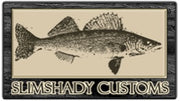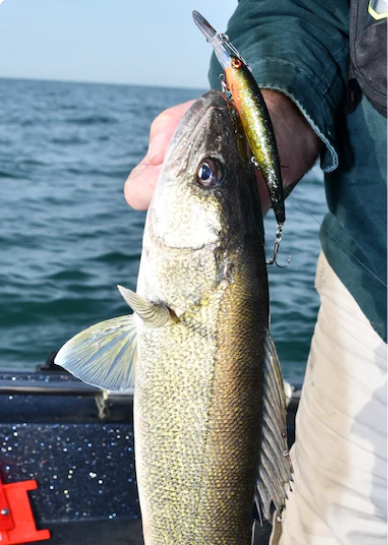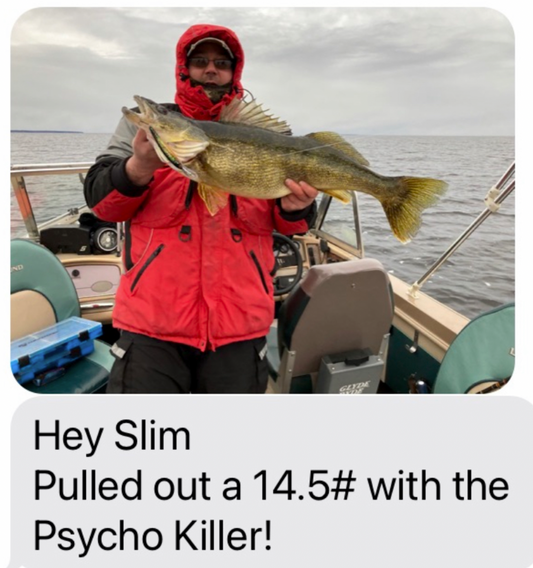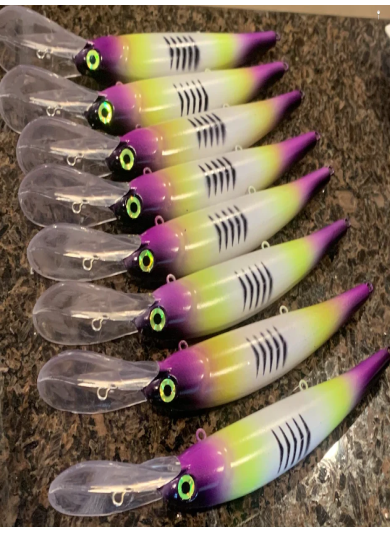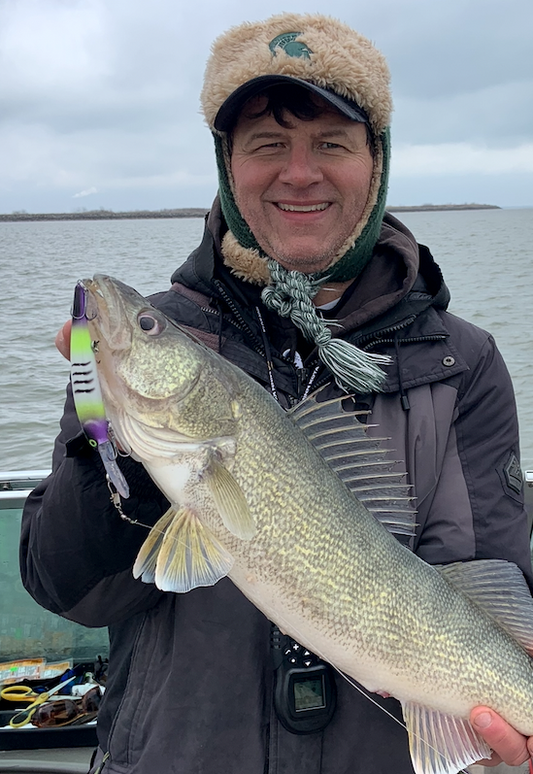Article: Detroit River Jigging Tips
I know, you are probably wondering why a custom crankbait maker is writing an article about jigging. Even though it is hard to beat trolling crankbaits when it comes to productivity and average size, jigging is still my favorite way to catch walleyes. Some people think that the jigging season is over in the Detroit River, however, that is simply not the case. This time of the year can produce awesome action and a variety of species.
That said, as the season gets deeper into May or even June, the water tends to be clearer, even on the Canadian side, which means that you have to focus your jigging efforts during the lower light periods, or during the right weather/sky conditions.
This time of the year, I like to do "combo trips", where I start out jigging and then switch to trolling as the sun gets higher in the sky. If I am fishing the mid-river area, I might switch to pulling harnesses. If I am in the lower or upper, I might switch to trolling cranks, either in Erie or Lake St. Clair.
For those of you who are new to jigging, I am going to cover the basics in this article. If you are a jigging veteran, you might still pick up a few nuggets of info here and there.
Equipment:
For starters, vertical jigging in the Detroit River requires a certain type of rod/reel/line combination to be most effective.
- Line type is the most critical. Braid is a must. I prefer hi-vis lines in yellow/lime or white, as it allows me to see my line better. 6-10 lb test is plenty. I prefer using a 10-20 lb test flouro or green mono leader, 18"-24", either tied to a small barrel swivel or tied with a uni-to-uni knot. I like heavier leaders later in the spring for the occasional musky.
- As for the rod, graphite is a must, but you don't need to break the bank. I have two Lew's graphite rods that I love, that I paid around $80 each for. 6'2", medium, fast-action. I prefer rods that are between 6' and 6'6". Longer works, but they tend to cause more jigging fatigue. If your rod is too wimpy, with no backbone, you will have trouble feeling bites. Same with the other way, if it is too stiff, like a pool cue, you will not have any feel either.
- The reel is the least important part, but I like reels in the 2000 or 2500 size, so that they are light in my hands. Again, fatigue factor. I like reel handles that are grippy, especially when I have to find it quickly to reel a fish in after setting the hook.
You must keep your lines vertical:
When I say at all times, I mean at all times. If you aren’t vertical, you will have almost zero chance of catching fish consistently. Therefore, you need a trolling motor or kicker to counteract the wind. If you are using a bow mount, point your bow into the wind, set your motor to a speed just high enough to correct your position as needed and start fishing. Only use the motor to correct your position as the wind pushes you off of vertical. Most newbies struggle with this at first, especially when trying to learn to jig and operate the boat at the same time. It is like rubbing your stomach and patting your head. This is another big reason I would recommend going with a guide (or another veteran) the first few time or two.
What I like to do when I pull up to a spot, is cut the big engine early enough, so that you are still drifting towards your final spot as you are getting you rod ready to fish. Put the trolling motor down and turn the bow towards the wind (for bow mounted units). Once you have stopped moving (relative to the water), drop your jig down. As the wind pushes you backwards, use the motor just enough to pull you back to vertical. However, don’t wait until you are way off vertical to adjust. When I feel a big gust of wind against my face, I usually hit the motor right away to counter-act it, instead of waiting. If the wind pushes me more than a few inches off of vertical, I will adjust it. As far as which way to adjust, that should be easy. Just follow your line. If your line is going off to the right, then you need to motor to the right until your line is straight up and down again.
If you are using a trolling motor with a hand-held remote (Terrova, Ulterra, etc), the process is a bit different. In that case, I keep the remote on a lanyard around my neck and in my left hand as I jig with my right. I put the motor on auto-pilot and point it towards the direction of the wind. It is critical that you choose the "classic" auto-pilot and not the "advanced" version. Classic is the compass-based one. Advanced is the GPS-based one, which doesn't work well with current, as it will want to take you back up-stream all the time. Once I have the correct AP set, I pick a speed that is even or slightly below the average wind speed. As the wind gusts push me back, I hit the "rabbit button", which takes the motor to full speed, but just for a second or two and then hit it again, which takes me back to my previous speed. This works way better than constantly changing speeds.
IMO, the ultimate trolling motor for jigging is the Ultrex, as it is a hybrid between a cable-steer and a Terrova/Ulterra. It allows me to control it with my foot, yet still use the hand-held if/when I want and have all of the same features as a Terrova/Ulterra for trolling. I have not tried the new motors from Lowrance or Garmin, so I can't comment on those.
Location/Spots:
You can catch walleyes almost anywhere on the Detroit River. Deep, shallow, heavy current, light current, etc. It all depends on the time of the year, time of day, weather, sun, etc.
That can be very over-whelming, especially for newbies. Therefore, if you are new to the Detroit River, look for break-line areas near the main channel edges where the contour lines are a bit further apart, or flats that are just off the main channel with water that is between 20-30 feet deep. If you are just getting started, it is much easier to feel the bottom in those depths than it is trying to learn in 35-45 FOW.
Start in the shallower water and move deeper as the day goes on. If you are fishing in water less than 25 feet deep, be careful about making lots of noise, banging the bottom of the boat, etc. This will spook the fish.
If you are new to jigging, start with 3/4oz jigs and go up if you have trouble feeling the bottom. Once you get the hang of it, you can drop down to ½ oz in water less than 30 feet. In water deeper than 35, you may need 1oz jigs. I have had my best luck on 1/2 oz jigs, so go lighter if you can, but only after getting the hang of it.
For big fish, go shallow:
Almost all of bigger females will be found in water less than 30 feet. I have seen 12 lb fish come out of 10-12 FOW. If you want bigger fish, go shallower, find slacker current, stay away from the packs and find slightly stained water. The bites will be fewer, however, the fish will be bigger. If you want quantity, look for the packs of boats. As a newbie, that is a good place to start, so you can get the hang of the jigging motion. Seeing others catch fish builds confidence as well.
Baits/Colors/Minnows, etc:
There are a zillion options when it comes to choosing your baits, colors, etc. I like minnow shaped baits vs worms, but both will put a ton of fish in the boat for you. When it comes to brands, etc, it is hard to beat the products that Jon Bondy puts out. Plus he is local to the area and knows the river as well as anyone. His baits are more durable than anything out there, and they flat out catch fish. He will be shipping 2 and 3 color options soon, so watch out!
My favorite colors are blue-ice, chartreuse-ice, purple and silver flake (not sure what the actual name is on that one).
Early in the year, I like to tip my jigs with a minnow. To keep them on better, I like to add a small piece of discarded plastic worm over the minnow. After the water hits about 50 degrees, you will not need minnows. Some guys do very well never using minnows, however, I do think they help on those tough days. You will need stinger hooks until the water hits 50-55 degrees. If you start seeing most of your fish coming on the main hooks, then you can get rid of the stinger.
Jigging Motion:
Early in the season, I usually keep my jigging motion very subtle. I am only moving the rod about 4-8 inches, with a pause at the top of the stroke anywhere from 2-5 seconds. Sometimes longer. Later in the season, as the water warms, I will usually increase the length of my jigging motion, but still not super high. Maybe 10-12 inches as my "go-to", but I will vary it until I know what they want.
Before I drop it back down, I make sure the line tightens & drop it down slowly, keeping the line tight as I drop. I make sure that I do not drop it faster than the jig can fall. This is critical. You will see some guys out there that look like they are jigging for tuna. If those guys catch any, they are usually snagged. Walleyes will almost always hit it right before it hits the bottom, so try to keep it close to the bottom, but not on it. Do not let it drag, even for a second. As soon as it touches bottom, jig it back up. For newbies, I tell them to imagine the bottom is a hot stove, and the jig is your hand. You let it touch just long enough to know that it is there and then back up.
You can hover it just barely off the bottom, just not on it. It helps a ton to have a depth finder that you can see while you are jigging. That way, you know when the depth changes, so you can adjust the amount of line you have out. If you are using heavy enough jigs, you shouldn’t have any issues feeling the bottom. However, if you lose contact with the bottom, reel it up and start over. Do not keep letting out line. If your line is not straight up and down, reel it in and start over. If it is 25 feet deep, you should have about 26-27 feet of line out, just enough to touch bottom and have some line out of the water up to your rod tip.
Snags:
If you fish the mid to upper river sections, you should not have too many issues with snags. However, if you are fishing in a pack and get snagged, give it some slack, try to shake it off of the snag a few times. If that doesn’t work, just point your rod at the snag, grab onto the spool and let it break. Trying to go back upstream against the current, with other boats drifting down, will just earn you a bunch of enemies. I like to have an extra rod or two rigged up for when this happens. Just grab the other rod and keep fishing. Re-tie when it is time to move.
Water Color/Clarity:
Some of you may have read my article called "Reading water color for more crankbait walleyes" that is also in my list of blog posts. Water clarity is just as important to jigging as it is to trolling cranks. Again, I prefer the greenish tinted water vs the super clear or chocolate milk.
You need a minimum of 6-12 inches of visibility to catch fish. 18-24 inches of visibility is best. Drop your jig down and determine when you can't see it anymore. If it is less than 18 inches, you may want to move. The US side is almost always cleaner. However, we do better in water with just a slight tint, vs. crystal clean, especially in the afternoon (slight tint would be visibility of 12-18 inches). Crystal clear would be visibility over over 24 inches, sometimes as much as 3-4 feet. If you can see your jig more than 3 feet down, you may want to find some water with a little more tint to it. Especially in the afternoon. The CAN side is usually more stained, as is the area just downstream from the rouge. If it is really muddy, (less than 12 inches of visibility), you can still catch them, however, mid-afternoon is better, and I normally stay shallower than 30 feet. I also prefer bright heads and dark bodied baits for those times.
If you can't see the prop on your motor, then it is too muddy and you either need to move or go home and watch fishing videos on YouTube.
Don't fish right behind your buddy:
If there are two of you fishing in the boat, make sure you are not fishing right behind each other. For example, if the wind is blowing right up the river, the boat will be facing downstream as you are drifting. If both guys are fishing out of the right side of the boat, the guy in front will be getting to the fish first, before the other guy has a chance to get them. In that case, have one guy fish out of one side, and the other guy out of the other. If you have 3 or more guys, just do your best to spread out. If the wind is blowing across the river, then you have to watch side to side of the boat instead. It may seem like a minor detail, however, details matter, especially with jigging.
Go with a guide or river vet to learn:
I would highly recommend going with a guide your first time. Jon Bondy is one of the best on the river, however, he can get booked up pretty fast. Captain Nick Homayed is another excellent choice, however, there are many options. You will learn more in one day going with a guide who is willing to teach, than you would by fishing on your own for the whole season. Think of it as an investment in your fishing education. With what it costs to own a boat, buy licenses, gas, etc. It is well worth it, IMO.
Good luck!!
